MARIANI’SVirtual
Gourmet
FEBRUARY
23, 2014
NEWSLETTER

❖❖❖
ANNOUNCEMENT:
The annual Charleston Food + Wine Festival will be
held March 6-9, with more than 80 events and a
stellar line-up of chefs and food writers including
Frank Lee, Jeremiah Bacon, Anthony Lamas, Chris
Shepherd, Frank Stitt, John T. Edge, Andy Ricker,
Anne Quatrano,
IN THIS ISSUE
CARNIVAL NEVER ENDS: SAMBA!
by Marcy MacDonald
NEW YORK CORNER
NYY Steak
by John Mariani
NOTES FROM THE WINE CELLAR
True Tales from Dallas Sommeliers
by Andrew Chalk
❖❖❖
CARNIVAL NEVER
ENDS--SAMBA!
by Marcy
MacDonald
Photos
from Riotour: Raphael David and Fernando Maia
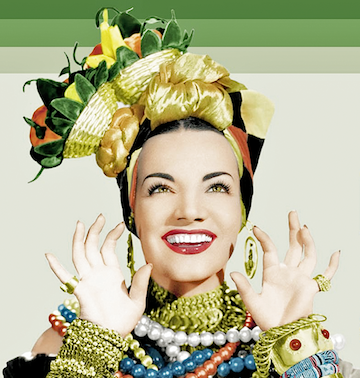
Carmen Miranda
"When my baby smiles at me, I go to Rio ... de
Janeiro." --Peter Allen.
Dress down and drink up: it's
Carnival season in Brazil!
"Lent is more like a brief pause
during a year-long party," says Brazillionaire
architect Rodolfo Doubek-Filho, who designed the
ultra-modern city of Curitiba. "The entrudos
(pre-parties) begin in October, and just get bigger
until five Fridays before Lent when the samba schools
erupt and take to the streets." Unlike most
riots: a very pretty sight.
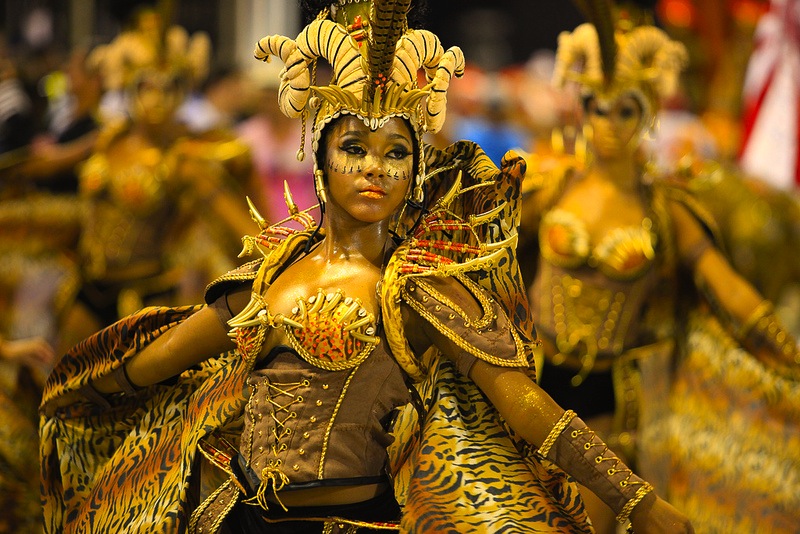 Incidentally, Doubek-Filho and
other veterans of the annual madness do what the late
Peter Allen did: they go to Rio.
Incidentally, Doubek-Filho and
other veterans of the annual madness do what the late
Peter Allen did: they go to Rio.
Cariocas--the residents of Rio--are among the
most gorgeous specimens on the planet, a product of
their Portuguese, French, African and pre-Columbian
diversity. Clearly, God mixed the human formula
perfectly here: Cariocas work hard and play hard; the
female of the species almost elevates thong-wearing to
an art form on the nation's beaches, from Ipanema to
Uba Tuba.
This national 'un'dress continues to inspire
the costumes not quite worn by Carnival revelers.
"Which makes it all the more amazing that a straight,
single man-about-town, Candido Claudio Vasse, would
cover up these perfect bodies by inventing Rio's first
Fashion University," adds fashionista Anna Maria
Tornaghi, reigning Queen of the Carnival's Masque
Ball, one of Rio's hottest tickets. Tornaghi seemingly
chairs nearly everything in Rio and heads the
committee for the city's 400th birthday party.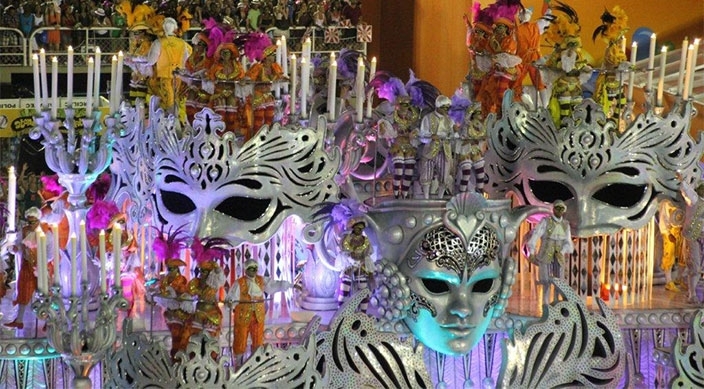
Imitations of the attire worn by the country's
first export to Hollywood, "Brazilian bombshell"
Carmen Miranda (aka: Maria do Carmo Miranda da Cunh)
who wasn't even Brazilian, are sometimes available in
the shops and stalls downtown called "Saara," but the
Carmen Miranda Museum is being relocated to Copacabana
Beach where it will continue to attract film addicts
and drag queens of every nationality.
Some of
the best (and briefest) costumes are still designed at
Casa Turuna, Carnival central since 1920. Others
can be purchased or rented through the Samba Schools.
Incidentally, the average cost to perform inside
the Sambadromo is between 5 to 7 million reais (USD$3 to 5
million) for each of the big samba schools, which
amounts to Big Business.
"The late Peter Allen was Carmen Miranda in
drag," asserts carnavalista
and author Angela Bowie, whose ex-husband, David,
credits Allen with shaping his career. "Peter and his
then-wife, Liza Minnelli, loved Carnival: its
influence on his performance could be seen in every
flamboyant rustle of his frilly samba shirts.
But the entire population of Rio is further out
than either Peter Allen or David Bowie." Amen,
sambasister.
"Keeping up with the cariocas isn't for the
feint of heart," she added. There is a kind of
Carnaval endurance course to complete before Rio's
banks, government buildings and various businesses
around Rua da Alfandega, Rua Buenos Aires and Rua
Uruguaina pull in their Welcome mats and lock their
doors for the annual celebration. Downtown
closes down everything but its saloons; even Paulo
Mamede's performance space in the historic section,
downtown closes everything but its saloons.
 People
who want to see the early parades will stay up from
the night before. For others, it goes something
like this: unless you're headed for a job, rise at the
crack of noon and proceed directly to Marius (left), barbecue
joint extraordinaire. Bring a thirst for a late
lunchtime caipirinha, caipiroska (relatively harmless,
made with vodka) or choppa (beer)
as you pick your salad from Marius' rooftop garden.
Graze and talent spot: the place is always packed with
famous faces, a few redesigned by the famous,
now-retired plastic surgeon, Dr. Ivo Pitanguy, who
received the Legion d'Honeur for his invisible seams,
His gorgeous and talented kids are now in the family
business.
People
who want to see the early parades will stay up from
the night before. For others, it goes something
like this: unless you're headed for a job, rise at the
crack of noon and proceed directly to Marius (left), barbecue
joint extraordinaire. Bring a thirst for a late
lunchtime caipirinha, caipiroska (relatively harmless,
made with vodka) or choppa (beer)
as you pick your salad from Marius' rooftop garden.
Graze and talent spot: the place is always packed with
famous faces, a few redesigned by the famous,
now-retired plastic surgeon, Dr. Ivo Pitanguy, who
received the Legion d'Honeur for his invisible seams,
His gorgeous and talented kids are now in the family
business.
Treat a hangover to acai in any
beach bar (or train by drinking Sambazon before you
leave home) or guarana,
the Amazonian energy bean available in everything from
chewing gum to cigarettes and sodas.
You'll need a reliable taxi driver (like ours,
Tony, the driver who never met a red light he didn't
run). It takes nerves of steel to ride in one of
the many altered VWs that dart through the city, but
if you survive the ride, roll to Arcos da Lapa and eat
your way from one end of the menu to the other
Fundição Progresso is now responsible
for the organization of the open-air Carnival event
"Rio Marchinha," in the area near Arcos da Lapa. The
national dish, feijoada (below),
is a long-running hit at the Casa de Feijoada, Caesar
Park, the hipper-than-ever Hippopotamus or the very
cool (and very pricey) Colombo Coffee Shop. Be seen at
the Palm and El Turf in the Jockey Club on Tuesdays,
the best night for the racetrack.  There are also gafiera dance
halls where you can hear cavaquinho (guitar)
and pandeiro (banjo)
music. Most feature Batucada -- song and dance that
requires foot-stomping, hand-clapping and enormous
quantities of alcohol. Weekly gay and lesbian parties
happen all over town, as Rio is very
gay-centric.
There are also gafiera dance
halls where you can hear cavaquinho (guitar)
and pandeiro (banjo)
music. Most feature Batucada -- song and dance that
requires foot-stomping, hand-clapping and enormous
quantities of alcohol. Weekly gay and lesbian parties
happen all over town, as Rio is very
gay-centric.
On Saturdays, head to Lapa's nightlife
district. And on Sundays, Bracarense in Leblon is so
jammed you can only get in with a whip-and-a-chair.
Consolation prize: The Hippy Fair in Ipanema, and
impromptu food fairs from beach to beach, all over
town.
Try the ramps. Since the French catered to
their Napoleonic Royals in Brazil, Cariocas developed
a taste for escargots.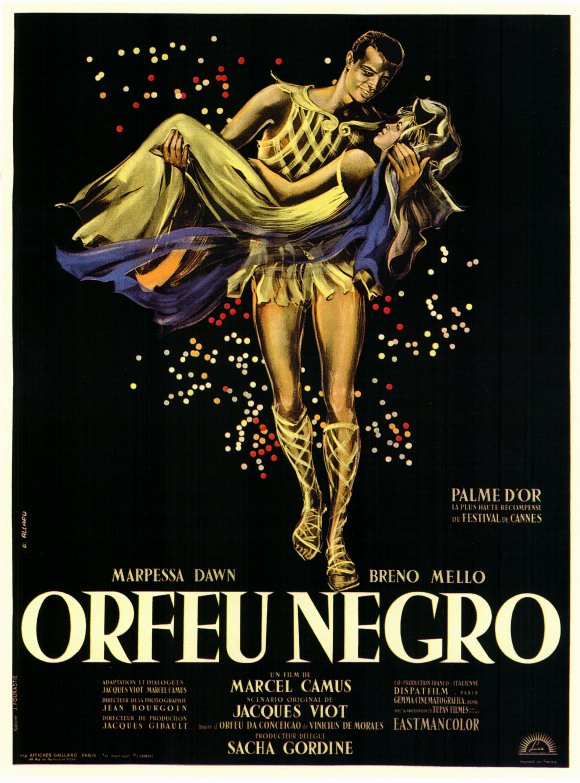 Now, the
University of Brazil has developed a method for
harvesting snails in only two months, rather than
France's two years. Add garlic and drawn butter to
taste and samba.
Now, the
University of Brazil has developed a method for
harvesting snails in only two months, rather than
France's two years. Add garlic and drawn butter to
taste and samba.
"Think of the movie 'Orfeo Negro' ('Black
Orpheus') as a kind of training film for Carnival,"
affirms the supreme sambanista,
Mary Wilson. "Antonio Carlos Jobim's score for the
film put samba's bossa nova beat on the international
music map,” which is why Rio's most famous saloon may
be the Bar
Garota de Ipanema where Jobim and Vinicius de
Morais composed “The Girl From Ipanema.” Samba
along the undulating, sea-wave roadway from Copacabana
Beach uphill to the sidewalk outside famous late
samba-music man, Noel Rosa's home, where it turns into
musical notes that comprise his compositions. The
93-year-old icon Bibi Ferrirea still has perfect
pitch, still has her own troupe, still keeps this
generation of the Jobim family gainfully employed, and
still tours: if you can get a coveted ticket, she
plays New York after Lent.
From
the perspective of any of Rio's lofty viewpoints --
take a long look at the Tijuca rain forest (planted by
a princess, a general and five slaves over a century
ago at the behest of Emperor Pedro II), the “lungs” of
the city. Of course, Sugar Loaf Mountain dominates the
entrance to the harbor, its huge art deco Christ the
Redeemer statue on the 'hunchback' Corcovado mountain,
reigning high above the skyline.
Every structure in Rio seems to be occupied,
pulsating at every hour, the perfect backdrop for the
phalanx of hang gliders who follow the air currents to
the ocean where a 24-mile beach party begins each New
Year’s Eve and runs until Bibi sings. The
Terreira o do Samba's concerts are surrounded by food
and drink, singers, dancers, acrobats on every
beach. Appearances of various bands -- including
the Ipanema Band, Carmen Miranda's Band (comprised of
fabulous drag queens), as well as the popular Simpatia
e Quase Amor, Corda o do Bola Preta, and Survaco de
Cristo -- are announced in the local papers (and, now,
websites).
When the Cidade Marvilhosa's 19th century elite
held formal bailes
(masquerade balls) and processions, they excluded
the poor of the
favelas slums. And yet it was there that the
most famous escolas
de samba (samba schools) would be born; there
the local jongo music would evolve into the tympanic
Ze Pereira bands that give Carnival it's urgent,
irrepressible beat.
Many of the important Masque Balls samba in
Copacabana, the most famous at the Orient Express
Copacabana Palace Hotel,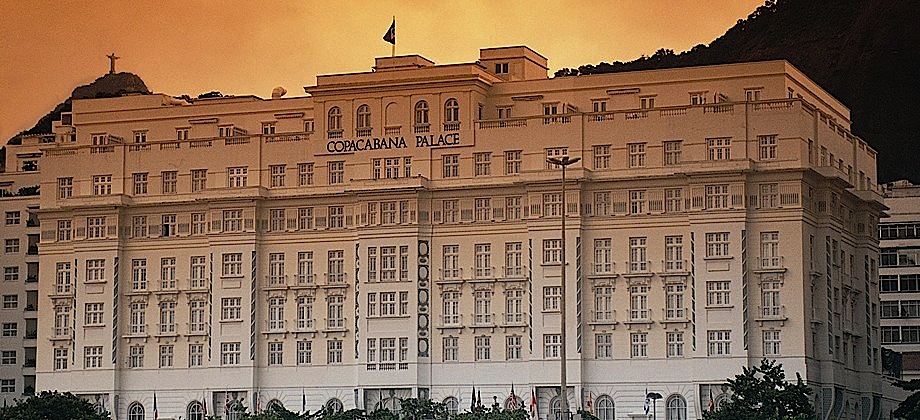 and along
Ipanema Beach. This year, there will be a revival of
the famous celebration at the Port, alongside several
Carnival Balls sponsored by Devassa Beer. They are
being called Devassa Balls and all of them will be
held at the renovated warehouses at the Port of Rio.
The City of Rio’s official opening Gala Ball will be
the first one in the city, and the last--but certainly
not least--is the Great Gala Gay Ball, on the eve of
Lent, the last day before Cariocas get religion.
and along
Ipanema Beach. This year, there will be a revival of
the famous celebration at the Port, alongside several
Carnival Balls sponsored by Devassa Beer. They are
being called Devassa Balls and all of them will be
held at the renovated warehouses at the Port of Rio.
The City of Rio’s official opening Gala Ball will be
the first one in the city, and the last--but certainly
not least--is the Great Gala Gay Ball, on the eve of
Lent, the last day before Cariocas get religion.
Book
a samba class to get your Carnival muscles in shape.
The most expensive occur on weekends when
tourists feel obliged to appear en masse in Rio's
poorest neighborhoods. Whether to observe or
participate, take a week-night class at Beija-Flor,
Imperio Serrano, Imperatriz Leopoldinense, Mangueira,
Mocidadle Independente and Portela schools in the Zona
Sul (southern Rio), which often create the richest and
most colorful high-energy performances with flawless
spontaneity. Classes cost an average of R20 in the
beginning to R$50,00 (USD $12-$30) in the last
days before Carnival in the main samba schools like
Mangueira, Salgueiro, Unidos da Tijuca, Beija Flor and
others. Each samba school has a different weekday for
its 'undress' rehearsal, so check their own websites,
radio and television stations and local newspapers--if
you read Portuguese. Samba if you don't.
 Samba school ranchos and desfilars
are parades that may require tickets, which are
available from September, on, but the only parade that
requires a ticket is the main one. It's
expensive to participate in a parade, but the schools'
parade ticket price often includes costumes and a seat
in the stands. Check the fine print. The smaller samba
schools of the bairros
organize Blocos,
informal street processions. You don't need a costume
or a ticket for the Blocos and their performance schedules
are very, very flexible. Many of the schools
samba all the way from the favelas to
Ave. President Vargas to show their stuff at the
massive, sculptural Sambadromo (designed by the late
Oscar Niemeyer), the real location of the parade as
samba schools don't do any formal parading before
that.
Samba school ranchos and desfilars
are parades that may require tickets, which are
available from September, on, but the only parade that
requires a ticket is the main one. It's
expensive to participate in a parade, but the schools'
parade ticket price often includes costumes and a seat
in the stands. Check the fine print. The smaller samba
schools of the bairros
organize Blocos,
informal street processions. You don't need a costume
or a ticket for the Blocos and their performance schedules
are very, very flexible. Many of the schools
samba all the way from the favelas to
Ave. President Vargas to show their stuff at the
massive, sculptural Sambadromo (designed by the late
Oscar Niemeyer), the real location of the parade as
samba schools don't do any formal parading before
that.
Just take the metro to Largo do Carioca or
Cinelandia. Many streets are closed to traffic as the
participants are inside the Sambadromo, at the "concentracao
area", so you may want to experience Rio's
famous subway to get there-and-back in time to
celebrate.
Inside the enormous structure, performances
begin before an audience of about 90,000 every single
night, foul weather or fair: great deal of alcohol is
available from the VIP section to the nosebleed seats,
in the not-so-cheap seats up with the Gods.
On Carnival Sunday, be at
Avenida Rio Branco and Boulevard 28 de Setembro for
amazing displays that begin at about 7:30 in the
evening. On Sunday and Monday nights, the top 12 samba
schools compete for the grand prize. The jury
announces the top three winners on Ash Wednesday, and
on the Saturday after Carnival, a Champions' Parade is
held, starring the best samba schools of the year.
If you're still alive, don't miss it: these are
the people to watch for
next year.
watch for
next year.
If you've had too much fun, and wish to repent:
Catholicism is the official national faith, but true
believers have made Soccer, Samba and Santoria--not
necessarily in that order--a religious experience. The
downtown Benedictine monastery with its eye-test disco
floor is presided over by St. Benedict and his sister,
St. Scholastica, imported to the Southern Hemisphere
by the Jesuits whose monasteries flourished wherever
there were indigenous souls to convert.
Some terreiros
(traditional houses of worship) are as open to the
public as cathedrals. Book Tenda Espirita or Palacia
de Iansa -- or arrive unannounced at Jeronimo. As for
entering a futbol stadium: Pele is a national
treasure. Samba accordingly until the first entrudo
begins in the stands.
How to get there:
Book American
Airlines for direct service in and out of Rio, or
fly Delta via Atlanta or sail in to Rio's enormous
harbor on one of the small Azamara or large
Celebrity or Princess ships. Sign away your
life (for $150) for a Visa at your local Brazilian
Embassy or Consulate.
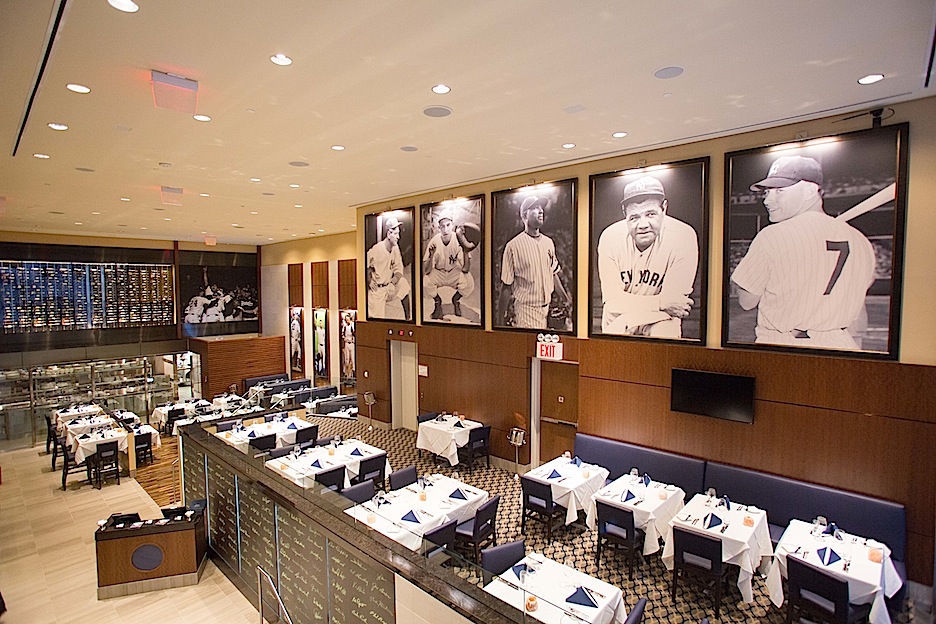 NEW
NEW
YORK
CORNER
by John Mariani

7 W 51st Street (near
Fifth Avenue)
646-307-7910
nyysteak.com/manhattan
Not for the first or last time
will I wonder when NYC will achieve a surfeit of
upscale steakhouses. Actually, I think NYC--as
well as most U.S. cities--already has a
surfeit, yet the genre keeps expanding almost
month by month. In just the past year,
we've seen the opening of Delmonico's Kitchen,
Morton's on Wall Street, Bobby Van's Broad
Street, Del Frisco's Grill, Davio's, Costata, S
Prime, Polo, Gallagher’s, and Quality
Italian, all more or less derivatives of the
original NYC steakhouses of the post-speakeasy
era, especially Palm on Second Avenue.
Some don't even
try to break the ancient mold, while others have
distinctly enhanced menus with more pastas and
sushi-style dishes and many of the new ones have
tried out extravagant new décors designed
to attract as many women as male
customers. Wine lists have grown
exponentially since the first Smith &
Wollensky on Third Avenue upped the ante back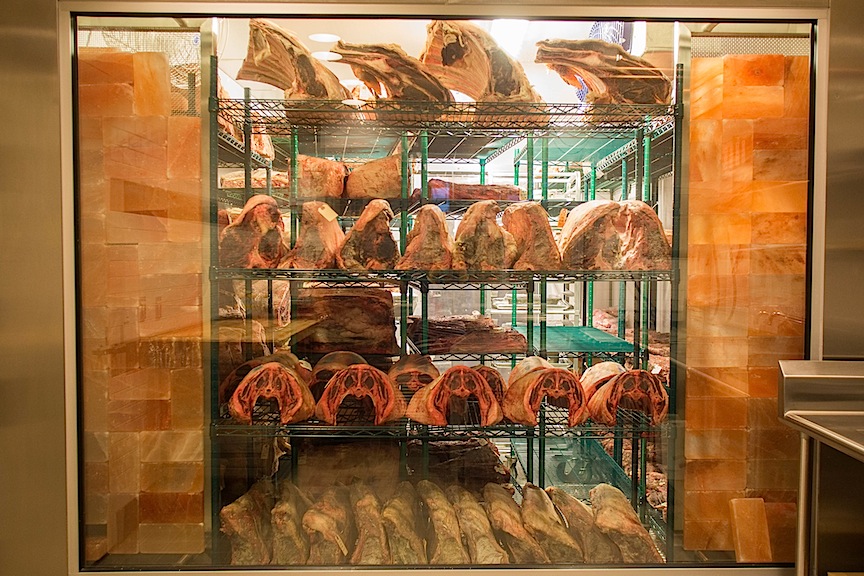 in the
1990s.
in the
1990s.
Now comes NYY Steak, actually
the third in a mini-chain owned half by the New
York Yankees (there's a unit in Yankee Stadium)
and half by--ready for this?--the Seminole
Indians of Florida, who have apparently done so
well with their casino and steakhouse in Coconut
Creek, that they bought out the hotel chain in
which the casino resides--the Hard Rock Cafe
empire.
The brand new Manhattan
branch is rife with Yankees' memorabilia,
blown-up photos of the Bombers' great players,
even dishware shaped like baseball
diamonds. Steak knives are etched with
players' and guests' names and displayed on the
walls. The restaurant's vast two-story
structure, all 16,000 square feet of it, has
plenty of space for private dining and parties,
including one room built into a former bank
vault, and, of course, the requisite long bar
and huge TV screens.
Its location right across
from Rockefeller Center makes it a draw for
office workers, pre-theatergoers and tourists
coming to the area. Del Frisco's and
Del Frisco’s Grill are a stone's throw away, so
NYY Steak's management is bending over backwards
to pull clientele from the area, counting on
their association with the Yankees but also
providing a level of service and hospitality not
so easily found in the old-line East Side
steakhouses where arriving unknowns are likely
to be treated with a shrug. CEO
Fred Thimm, formerly of the Palm chain, has been
canny enough to poach a cadre of veterans like
himself from other NYC steakhouses.
At NYYS, pretty hostesses
greet you by your name on the rez book, and the
rest of the staff, from captains and sommeliers
to waiters and busboys, are ever trying to
impress you with their dexterity in serving and
removing dishes, crumbing tables and placing new
napery on them.
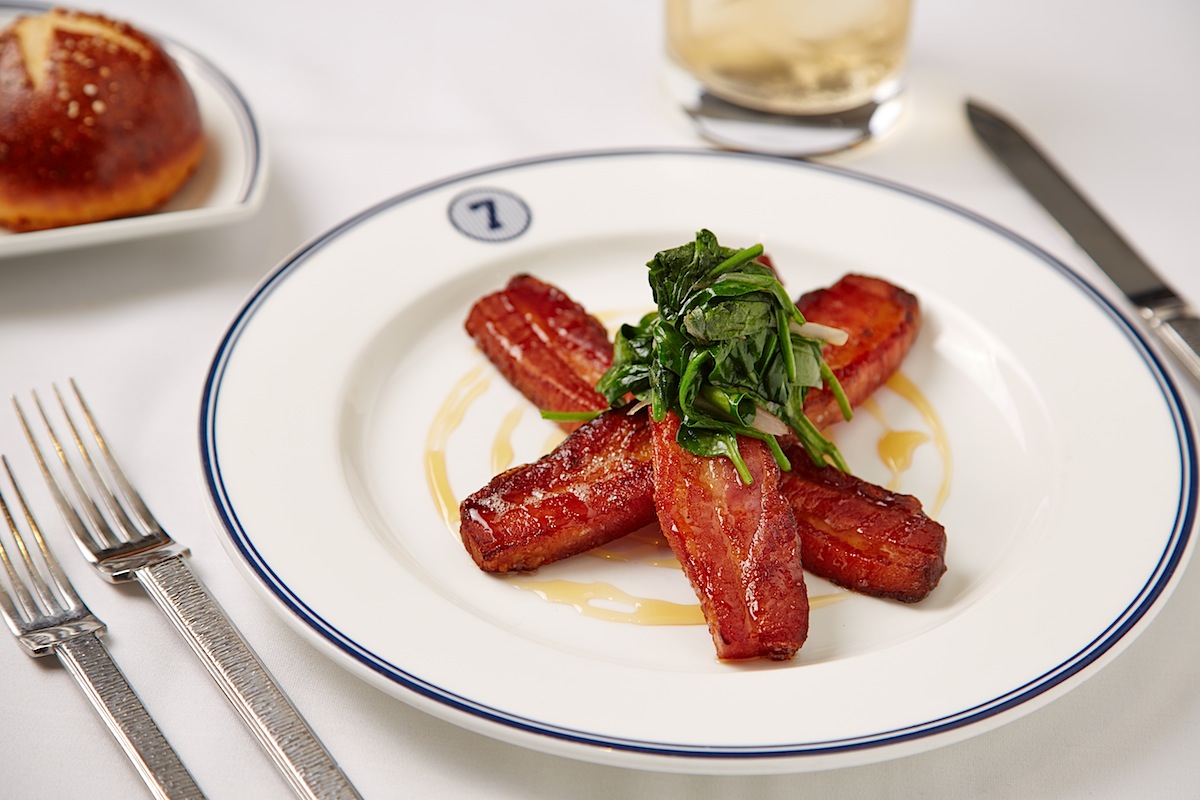 The wine
cache holds 200 labels, with 27
wines by the glass—many way overpriced, like J.
Lohr Seven Oaks Cabernet, which sells for $12
in the store, here $13 for a single glass! The
bar specializes in signature cocktails like the
Yankeetini and the Bronx Bomber. From
4 PM to 6PM and 9 PM to 11 PM weeknights, the
restaurant offers “Pinstripe Power Hour”
offering bites from the bar menu.
The wine
cache holds 200 labels, with 27
wines by the glass—many way overpriced, like J.
Lohr Seven Oaks Cabernet, which sells for $12
in the store, here $13 for a single glass! The
bar specializes in signature cocktails like the
Yankeetini and the Bronx Bomber. From
4 PM to 6PM and 9 PM to 11 PM weeknights, the
restaurant offers “Pinstripe Power Hour”
offering bites from the bar menu.
Exec chef Elliot Lopez is not trying to
re-invent the steakhouse genre but he is being
very careful to invigorate it. So
you begin with a generous ahi tuna tartare with
guacamole, Mandarin orange sesame
dressing, and a chile aïoli. The
lump crab cake is hefty and good on its own,
enhanced with roasted chipotle corn salsa, and
caper rémoulade, while the “colossal”
shrimp cocktail lives up to its name in size and
flavor, with punchy horseradish cocktail sauce.
A 16-ounce chunk of bacon (above) is
not unique in steakhouses, but NYYS’s is one of
the best and juiciest I’ve had, with an equal
ratio of fat to lean, made even tastier by a
maple glaze and wilted spinach.
There
are all the usual side dishes here—garlic mashed
potatoes, big fat steamed asparagus, steak
fries, creamed spinach with plenty of cream, and
onion rings the size of hockey pucks, though
they had far too much breading and not enough
onion inside.
And so, how was the beef? Well,
it’s all USDA Prime and dry-aged 21 days in
their own lockers, 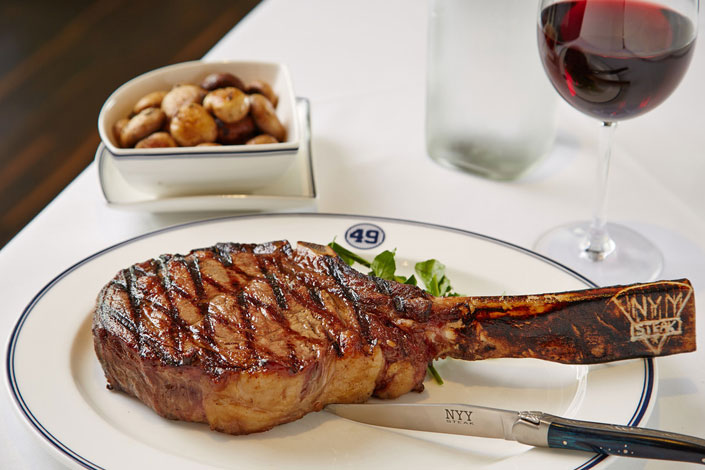 which are visible in
the restaurant.
(Frankly, any aging longer than 21 days
becomes more a conceit than an improvement.) The
NY strip was excellent, well-trimmed and
beautifully charred, as was a 27-ounce bone-in
ribeye of terrific succulence. There
was some difference of opinion on the provenance
of the lamb chops: the manager said they were
from New Zealand, the chef from Colorado. In
either case, they weren’t the best or most
flavorful I’ve had in NYC.
which are visible in
the restaurant.
(Frankly, any aging longer than 21 days
becomes more a conceit than an improvement.) The
NY strip was excellent, well-trimmed and
beautifully charred, as was a 27-ounce bone-in
ribeye of terrific succulence. There
was some difference of opinion on the provenance
of the lamb chops: the manager said they were
from New Zealand, the chef from Colorado. In
either case, they weren’t the best or most
flavorful I’ve had in NYC.
Nothing to quibble about, however, with
the three-pound lobster I ordered: the
tail was sweet and tender, the claws completely
full of meat, not shrunken from the shell, and
the clarified butter and lemon all that was
needed to achieve perfection.
In the manner of some but not all
steakhouses, NYYS offers various sauces like
Béarnaise, au poivre,
and blue cheese as additives, but charging seven
bucks for each is not playing nice.
You really won’t need dessert but at
least one should be tried—the NYY Steak 151 Volcano, vanilla
bean ice cream covered with HeatH Bar crunch and
expertly flambéed tableside using a shot
of 151 Rum. Or maybe the gargantuan wedge of
chocolate layer cake with berries, mousse and
warm fudge.
There is clearly a conspiracy afoot at
NYY Steak to overwhelm you with portions,
service and the kind of food few people can
resist. Tossing
in a whole lot of glitz, bar action, roominess,
and a truly affable spirit makes for a good
backdrop, especially if, at any moment, Alfonso
Soriano or Derek Jeter might come through the
door.
Hours: Lunch and dinner daily.
Dinner starters $11-$19, main courses $32-$62.
NOTES FROM THE WINE CELLAR
True Tales from Dallas Sommeliers
by Andrew Chalk
 If you work
in the hospitality industry you serve humanity. You
are bound to come across all types of people and
accumulate some funny anecdotes over the years, so
recently I surveyed Dallas sommeliers about the soft
underbelly of wine service.
If you work
in the hospitality industry you serve humanity. You
are bound to come across all types of people and
accumulate some funny anecdotes over the years, so
recently I surveyed Dallas sommeliers about the soft
underbelly of wine service.Anthony Martinez at The Gaylord Texan handles thousands of wine orders a week. He still remembers the time that a table asked for straws and drank their wine from a straw. Another time, a guest tasted the wine straight from the bottle.
Jennifer Jaco recalls an episode when she was at Del Frisco’s: “I once had a guest ask me to take his bottle of wine, decant half and put the other in a blender for five seconds, then asked me to pour the wine into two glasses to see if I could tell the difference. It was a really nice bottle so I couldn't bring myself to oblige, so I asked the bartender to do it. Besides the fact that the blended wine looked like a raspberry smoothie, all it did was make the wine smell like mint because they had been making mojitos in the blender all night.”
Russell Burkett at Sēr once had a regular customer order Cabernet by the glass, accompanied by Sweet & Low, and a glass of ice cubes.
Jeremy King of the Gaylord Texan reports, “I've had a guest ask me to put two different wines in the same glass because he liked different things about each wine Once we had a lady come in and tell her friends and the sommelier on duty that she could take the sulfites out of a glass of wine. She then asked the sommelier for the cork but said, `It can be anything you pull out of your purse.’ She moved the cork in a circular fashion inside the glass seven times, noting to her fellow guests to `make sure you don't touch the sides of the glass.’ She then repeated the procedure for each person's glass of wine and announced that their wines were now sulfite-free.”
Some problems arise due to misunderstandings about wine. Anthony Martinez says, “I find it humorous when the cork is passed around
 a table of four to six guests for
everyone to smell. It’s even more humorous when they
smell the side that has had no contact with wine. And
at least a half dozen times a guest has ordered a $60
Zinfandel expecting a Blush, and said they were
willing to pay over $60.”
a table of four to six guests for
everyone to smell. It’s even more humorous when they
smell the side that has had no contact with wine. And
at least a half dozen times a guest has ordered a $60
Zinfandel expecting a Blush, and said they were
willing to pay over $60.”Chris Morgan recalls one time at Oceanaire, “I had some guests order a Silver Oak Alexander Valley Cabernet Sauvignon--with two seafood dishes, if I remember correctly--to be served between their first and main courses. I pulled a bottle out of our temperature-controlled cabinet and decanted it at the table for them. The process was seamless and the entrees were delivered just as I finished the wine service. The server alerted me that the table wished to speak with me not long after the entrees had been delivered. `Is everything prepared perfectly?’ I
 asked. `This wine is cold,’
the gentlemen replied, `much colder than we like it.
We thought we could get used to it and tried to like
it, but we just don’t want to wait for it to warm up
while our food gets cold. Could you bring us a
bottle that isn’t so cold?’ I replied, `We do keep
certain selections at cellar temperature; 55 degrees
is the best temperature to store and serve fine red
wines. I’m sure it wouldn’t take long at all for
the wine to come up to a more agreeable temperature
for you.’
asked. `This wine is cold,’
the gentlemen replied, `much colder than we like it.
We thought we could get used to it and tried to like
it, but we just don’t want to wait for it to warm up
while our food gets cold. Could you bring us a
bottle that isn’t so cold?’ I replied, `We do keep
certain selections at cellar temperature; 55 degrees
is the best temperature to store and serve fine red
wines. I’m sure it wouldn’t take long at all for
the wine to come up to a more agreeable temperature
for you.’ “`Well, this is much colder than we like or are used to,’ he said. `Could you bring us a bottle that is closer to room temperature?’ Grudgingly, I removed the decanter, the bottle and their glasses, then repeated the process with a bottle from storage that was at room temp or above. I returned to the table near the end of their meal, and they both expressed sincere gratitude for exchanging their `cold’ wine for a bottle that was `a more proper temperature.’ That experience reinforced the adage that the guest isn’t always right, but they are the guest, and have the right to be wrong.”
 OMMMMM (HICCUP!)
OMMMMM (HICCUP!)In Brooklyn, NY, Isa restaurant invites guests to sit at long communal tables and learn about subjects like the "mindful feast," with author Lodro Rinzler explaining how to "be present" while drinking wine. A post-meditation dance party was cancelled because, said the owner of the restaurant, "Everyone was so Zenned out."
YES, BUT SOCHI IS STILL AT
THE TOP OF THE PACK 
WHEN IT COMES TO BATHROOM SURVEILLANCE
!!
According a poll
conducted by travel dating site, MissTravel.com,
Dhaka, Bangladesh, and New
Delhi, India, have poor conditions comparable to
Sochi in this list of the “Top
8 Most Unpleasant Cities Rivaling Sochi”:
Top 8 Most Unpleasant
Cities Rivaling Sochi:
1. Dhaka, Bangladesh
2. New Delhi, India
3. Algiers, Algeria
4. Detroit, Michigan
5. Youngstown, Ohio
6. Port Moresby, Papua New Guinea
7. Guadalajara, México
8. Rio de Janeiro, Brazil
❖❖❖
Any of John Mariani's
books below may be ordered from amazon.com.
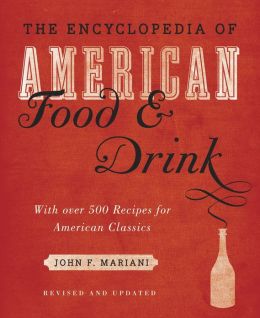 |
The Encyclopedia of American Food
and Drink by John F. Mariani
(Bloomsbury USA, $35) Modesty forbids me to praise my own new book, but let me proudly say that it is an extensive revision of the 4th edition that appeared more than a decade ago, before locavores, molecular cuisine, modernist cuisine, the Food Network and so much more, now included. Word origins have been completely updated, as have per capita consumption and production stats. Most important, for the first time since publication in the 1980s, the book includes more than 100 biographies of Americans who have changed the way we cook, eat and drink -- from Fannie Farmer and Julia Child to Robert Mondavi and Thomas Keller. "This book is amazing! It has entries for everything from `abalone' to `zwieback,' plus more than 500 recipes for classic American dishes and drinks."--Devra First, The Boston Globe. "Much needed in any kitchen library."--Bon Appetit. |
"Eating Italian will never be the same after reading John Mariani's entertaining and savory gastronomical history of the cuisine of Italy and how it won over appetites worldwide. . . . This book is such a tasteful narrative that it will literally make you hungry for Italian food and arouse your appetite for gastronomical history."--Don Oldenburg, USA Today. "Italian
restaurants--some good, some glitzy--far
outnumber their French rivals. Many of
these establishments are zestfully described
in How Italian Food Conquered the World, an
entertaining and fact-filled chronicle by
food-and-wine correspondent John F.
Mariani."--Aram Bakshian Jr., Wall Street
Journal.
"Equal parts
history, sociology, gastronomy, and just
plain fun, How Italian Food Conquered the
World tells the captivating and delicious
story of the (let's face it) everybody's
favorite cuisine with clarity, verve and
more than one surprise."--Colman Andrews,
editorial director of The Daily
Meal.com. "A fantastic and fascinating
read, covering everything from the influence
of Venice's spice trade to the impact of
Italian immigrants in America and the
evolution of alta cucina. This book will
serve as a terrific resource to anyone
interested in the real story of Italian
food."--Mary Ann Esposito, host of PBS-TV's
Ciao
Italia. "John Mariani has written the
definitive history of how Italians won their
way into our hearts, minds, and
stomachs. It's a story of pleasure over
pomp and taste over technique."--Danny Meyer,
owner of NYC restaurants Union Square Cafe,
Gotham Bar & Grill, The Modern, and
Maialino.
|
 |
 |
 |
 |
 |
 |
 |
 |
 Everett Potter's Travel Report:
Everett Potter's Travel Report: 
 Eating Las Vegas
is the new on-line site for Virtual Gourmet
contributor John A. Curtas., who since 1995
has been commenting on the Las Vegas food
scene and reviewing restaurants for Nevada
Public Radio. He is also the
restaurant critic for KLAS TV, Channel 8 in
Las Vegas, and his past reviews can be
accessed at KNPR.org.
Click on the logo below to go directly to
his site.
Eating Las Vegas
is the new on-line site for Virtual Gourmet
contributor John A. Curtas., who since 1995
has been commenting on the Las Vegas food
scene and reviewing restaurants for Nevada
Public Radio. He is also the
restaurant critic for KLAS TV, Channel 8 in
Las Vegas, and his past reviews can be
accessed at KNPR.org.
Click on the logo below to go directly to
his site.

Tennis Resorts Online: A Critical Guide to the World's Best Tennis Resorts and Tennis Camps, published by ROGER COX, who has spent more than two decades writing about tennis travel, including a 17-year stretch for Tennis magazine. He has also written for Arthur Frommer's Budget Travel, New York Magazine, Travel & Leisure, Esquire, Money, USTA Magazine, Men's Journal, and The Robb Report. He has authored two books-The World's Best Tennis Vacations (Stephen Greene Press/Viking Penguin, 1990) and The Best Places to Stay in the Rockies (Houghton Mifflin, 1992 & 1994), and the Melbourne (Australia) chapter to the Wall Street Journal Business Guide to Cities of the Pacific Rim (Fodor's Travel Guides, 1991).


MARIANI'S VIRTUAL GOURMET
NEWSLETTER is published weekly. Editor/Publisher: John
Mariani.
Contributing Writers: Christopher Mariani, Robert Mariani,
John A. Curtas, Edward Brivio, Mort Hochstein,
Suzanne Wright, and Brian Freedman. Contributing
Photographers: Galina Stepanoff-Dargery,
Bobby Pirillo. Technical Advisor: Gerry McLoughlin.
© copyright John Mariani 2014
